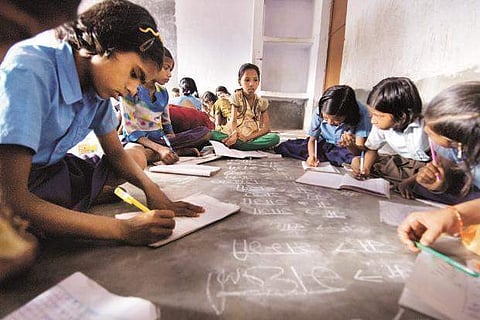

Amidst the cacophony coming from the one-room Tribal Welfare Primary School (TWPS) in Pawarguda of the Kumurambheem Asifabad district in Telangana, it was difficult to pinpoint the language being spoken by the students or the teacher. Nestled deep within the hilly forest areas, Pawarguda is situated very close to Chandrapur in the neighbouring state of Maharashtra. The myriad languages spoken by the students and their lone teacher, combined with the unfamiliarity of the languages in the textbooks and the surrounding community, created an alien linguistic environment for the students, reported The New Indian Express.
This is the norm in many schools across the region. Most of the students, hailing from tribal communities, either speak Kolami or Andh, while the teacher, who completed her education in Marathi many years ago, spoke Gondi. While the textbooks are in Telugu or English, the residents speak mostly Marathi, apart from their indigenous languages. To address this, the Tribal Welfare Department decided to merge the schools from Class III about two years ago. As a result, the primary schools have only till Class II, thereby, making the total enrollment relatively low. Most of the schools in the region don’t have more than 25 students, said sources.
The Tribal Welfare Department runs 1,920 of the 43,000 schools across the state. However, almost 40% (765) of such schools are managed by single teachers. Kumurambheem Asifabad, among all the districts in Telangana, has the highest number of single-teacher schools at 489, followed by 340 in Nalgonda and 297 in Bhadradri Kothagudem. In the rural parts of Gadwal, 67 such schools could be found. Additionally, another 285 schools across the district are managed by two teachers.
While the TWPS Pawarguda was supposed to be a Disha Model School with full-fledged infrastructure, as many as 20 students were sitting on the floor when TNIE visited the school. The children have no option but to relieve themselves in bathrooms with no doors. Soon after the lunch break, the teacher had to attend a mandal-level meeting, forcing the end of the day for the students much earlier than the scheduled closing time.
Schools across the region encounter similar challenges: rundown classrooms, unhygienic toilets, absence of a drinking water facility, absent compound walls and insufficient staff for maintenance. Experts say that teachers in such areas often have to make do with the minimum resources, as a result of which, the quality of education is affected. There are no libraries and no emphasis on extracurricular activities, which are crucial for the overall development of a student.
Low enrollment
In another single-teacher school in Jainoor Mandal, out of the 15 enrolled students, only six were present. Several were absent, engaged in cotton collection with their parents or attending the last rites of a person from a nearby village. The lone teacher, requesting anonymity, mentioned that another teacher was recently deputed to the school. Despite the challenging circumstances, everyone entered the classroom, sidestepping a dead puppy on the stairs. Later, one of the students was tasked with its disposal, The New Indian Express reported.
Even if not fully utilised for educational purposes, schools in this region serve various purposes. For instance, the TWPS Panapatar became a refuge for menstruating women due to social distancing superstitions. During the day, they engage in agricultural work, bathe in the nearby river and seek shelter in the school at night. Following numerous complaints, the women were instructed to relocate to the unused old building adjacent to the current premises.
